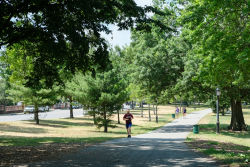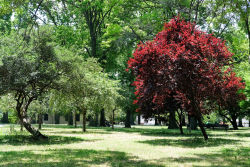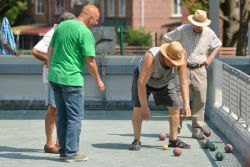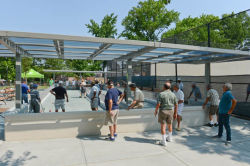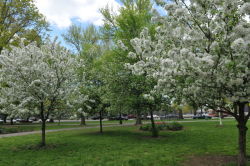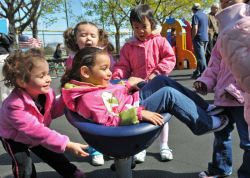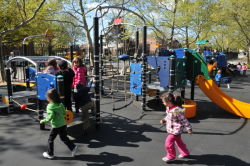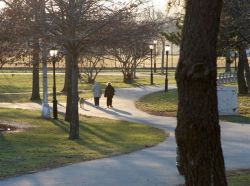Juniper Valley Park
Juniper Valley Park
What was here before?
This site was part of Juniper Valley Swamp, which covered around 100 acres from Caldwell Avenue south to Juniper Valley Road. The swamp and surrounding area were blanketed by a thick forest of juniper and white cedar trees. The site was later used as a farm, a cemetery, the property of notorious gangster Arnold Rothstein (1882-1928), and a garbage dump.
This site contained a substantial deposit of peat moss, disintegrated and partially decomposed vegetable matter. During the Revolutionary War, the British cut down almost all local timber for firewood and shipbuilding, and residents harvested the peat for fuel. A 1934 article in the Long Island Daily Press estimated that the peat bog measured 10 acres in area, 16 feet in depth, and 390,000 cubic yards in volume. Juniper Valley Swamp’s peat source was almost forgotten until 1916, when construction of a railroad freight connection cut through the bog, which was mined for landscaping material for parks and parkways.
How did this site become a park?
In the early 1930s, the City of New York acquired the bog to settle a $225,000 claim in back taxes against Rothstein’s estate. Rothstein, who was accused of fixing the 1919 World Series, purchased land in Middle Village on which he erected 143 flimsy houses with the hope of raising property values. Rejecting proposals to use Rothstein’s “Phantom Village” to build a municipal airport or civic center, government officials chose instead to develop the land as a park. The land and four adjacent parcels were acquired for park purposes between 1937 and 1949.
Part of the property included the Pullis Farm Cemetery, which is located on North 63rd Avenue near 81st Street. Thomas Pullis bought a 32-acre farm in Middle Village in 1822. The cemetery is one of the few surviving farm burial grounds in New York City and dates to at least 1846. A 1932 survey found three marble grave markers: one for a child, one for “J.H.G.,” and a third for Thomas Pullis, Sen. and possibly his wife Elizabeth. In his will, Pullis prohibited the sale of the cemetery, leaving instructions to build a brick perimeter wall to protect it. Another portion of Pullis’s property was sold to the parish of St. Margaret’s for their first church, built in 1860. In 1997 the Lutheran All Faiths Cemetery donated a new gravestone in memory of the Pullis family.
From 1941 to 1942, Works Progress Administration workers transformed the barren land with an extensive horticultural program and a host of amenities. Plans called for paths, playgrounds, fences, benches, a wading pool, and a variety of athletic facilities for tennis, paddle tennis, badminton, handball, shuffleboard, ice skating, and bicycling. Baseball and softball fields were built on top of the Department of Sanitation’s former landfill dump.
Juniper Valley Park was one of the first NYC Parks to have a synthetic turf field. Completed in 2003, it was surrounded by a new track built the prior year. Juniper South Playground was renovated in two phases in 2010 and 2011, which added new play equipment and a spray shower area with a pond theme. In 2014, the park’s bocce court area was renovated and expanded with an additional court and seating. The roller hockey rink was rebuilt in 2018, as was another spray shower area the following year. Most recently, the track and field area was improved with new surfacing, including hardscape and synthetic turf, and adult fitness equipment.
Check out your park's Vital Signs
Clean & Safe
Green & Resilient
Empowered & Engaged Users
Share your feedback or learn more about how this park is part of a
Vital Park System

